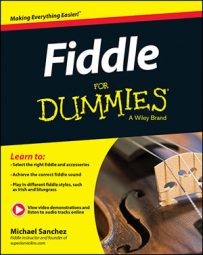Playing the fiddle requires you to be able to count music. If rhythms were all quarter notes, half notes, and whole notes, there wouldn’t be a reason to count any differently from the obvious way: If you see a quarter note you count to 1, if you see a half note you count to 2, and if you see a whole note you count to 4.
But what happens when you’re asked to play rhythms that aren’t easily counted? Sometimes you’ll come across a situation where you have to count a note that’s 1/4 or 3/4 beat. How would you count that?
The only way to do it perfectly is to consider each of these number values (rhythms) more than they actually are for a period of time so that you can count them easier. So if you multiply .25 or .75 by 4, you’d get 1 or 3. That’s a lot easier to count, wouldn’t you say? This system is called subdividing.
Everyone has a different method of counting properly, but subdividing is important because it works perfectly for any type of situation you’ll encounter. Sometimes you may have to read things over twice or even a third time to really understand this system, but when you get it, it’ll help you in any possible situation.
Here’s an easy rhythm with three different counting options. Line 1 would be taken at a speed of 60 BPM, line 2 would be at 120 BPM, and line 3 at 240 BPM. If you count each line at the specific beats and count the metronome clicks properly, you should clap the exact same way for each of the lines.
![[Credit: Figure by Michael Sanchez]](https://www.dummies.com/wp-content/uploads/459257.image0.jpg)
The first line is “counting in quarter notes.” This is the basic way to count that works when you’re dealing with simple rhythms. The second line is “counting in eighth notes.” Use this when you have a lot of eighth notes in a musical passage. The third line is “counting in 16th notes,” which you use when you see a lot of 16th notes in a passage.
Because this music line has no eighth or 16th notes, counting quarter notes (the first option) makes the most sense.
The graph shows what rhythm values would be if you counted them in quarter notes, eighth notes, or 16th notes.
![[Credit: Figure by Michael Sanchez]](https://www.dummies.com/wp-content/uploads/459258.image1.jpg)
Do you see where all the values equal 1? This is the base rhythm of each of the ways of counting. So, if you’re thinking in quarter notes, the base rhythm would be the quarter note, which equals 1. If you’re thinking in eighth notes, the base rhythm would be the eighth note, which equals 1. If you’re thinking in 16th notes, the base rhythm would be the 16th note, which equals 1.
Create flash cards of the rhythms, which will help you with subdividing difficult rhythm passages. Having this subdividing system embedded in your brain is valuable and will make you a lot better with rhythm, which leads to sounding better on the fiddle. You don’t want to be that guy who never knows how to count in a musical passage!
Here is a musical rhythm example where you may want to count in eighth notes. This means you use line 2.
![[Credit: Figure by Michael Sanchez]](https://www.dummies.com/wp-content/uploads/459259.image2.jpg)
Can you see how the second line makes the most sense? If you tried to count using the first line, you’d find yourself getting stuck because of all the decimal notes. Line 2 avoids all decimal notes and puts every number in a nice layout that anybody can count properly.
Because you’re counting in eighth notes, the metronome beat also has to double in speed. Set your metronome at 120 BPM; each click will then represent a number value for line 2.
Now that you understand how to count in eighth notes, consider a situation that requires you to count in 16th notes. This happens often in fiddle music, and you’ll find it much easier to count many passages in 16th notes.
Use this form of counting to first learn how a rhythm passage works, but don’t use it forever. You’d be counting a lot of numbers if you had to count this way every time! Thinking in 16th notes is like taking a microscope and seeing the details of something you wouldn’t be able to see with the naked eye.
This rhythm line is counted best in 16th notes.
![[Credit: Figure by Michael Sanchez]](https://www.dummies.com/wp-content/uploads/459260.image3.jpg)
This rhythm line is very difficult to count in simple quarter notes. The second line has a bunch of fractions that would be very difficult to count. As you can see in the third line, the numbers are almost all in non-fraction format, and it’s a lot easier to count.
Now that you're thinking in 16th notes, you want to increase the tempo of the metronome. Because 240 BPM is just too fast to hear the clicks, choose something more in the range of 180 BPM, which is technically much slower than the piece is supposed to be played. This is fine, because anytime you’re thinking in 16th notes, you’re breaking down the measure more.
The key to counting in music is figuring out what counting mode you should be in and then taking a pen and paper and breaking it down. When you begin to progress on the fiddle, you’ll be able to do this more on the fly. If you’re just starting out, you may even have to break down counting quarter notes, which is fine.

